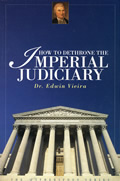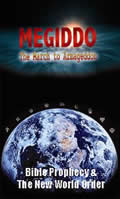Other
Sizemore
Articles:
The 'Passion', Why so Much Blood?
Judges Who Break the Law - Judges Who Steal
They Don't Steal All Our Chickens
Blame The Oregon
Supreme Court For The P.E.R.S. Problem
'Vote By Mail' A
Formula For Fraud
When Your Signature Doesn't Count
The Curse Of regional Governments
By Bill Sizemore
April 20, 2006
NewsWithViews.com
Over the centuries, there have been numerous heated debates regarding the allegedly lost books of the Bible or the Apocryphal books. Some scholars have claimed that the Bible should be bigger than it is, and at least a few of the other ancient manuscripts should have been included when the Bible was canonized.
The recent discovery of the 1,600 to 1,700 year old �Gospel of Judas� manuscript has renewed this centuries old debate. Perhaps you too have wondered whether the Bible is really complete. Maybe some of the other books that were floating around out there in the first few centuries A.D. should have been included, when the Bible was canonized.
After all, when the Bible was canonized, many centuries ago, it was mere humans who decided which books would be included and which ones should be left out. There were lots of books from which to choose, and the subject was hotly debated. How do we know they got it right? Was God involved in the process? Did He work behind the scenes to make sure the right books were included?
In this column, I am going to tell you why I believe God was involved and why the men who made the decisions, which resulted in the Bible we have today, got it right. I will offer a clue that God gave some 3,500 years ago, a clue which for many will settle this question, as it has for me. But first, let�s talk a bit about the curious timing of all the attention that is being focused on the Gospel of Judas.
The Judas manuscript, believed to have been written about 300 to 400 A.D., was discovered some years ago in a cave in Egypt. The discovery was not well publicized at the time. After it was found, the Gospel of Judas disappeared from sight and for several years moved through the murky back channels of the European and Middle Eastern black market for antiquities, passing from dealer to dealer.
Then, all of a sudden, this long lost manuscript, which contradicts in major ways all four of the New Testament gospels, burst on the scene, just as the world is being inundated by a flood of Hollywood hype promoting The Da Vinci Code, a sacrilegious movie claiming that Jesus never really died and rose from the grave, as the New Testament claims, but instead lived a long life married to Mary Magdalene and even had children by her, the descendants of whom are alive today.
Of course, if the Da Vinci Code is true, then the resurrection of Jesus Christ was a hoax and the Christian faith is meaningless. After all, the resurrection of Christ is the cornerstone of the Christian faith. There is no Christianity without the resurrection. As the Apostle Paul explains in his first letter to the church at Corinth, if Jesus did not raise from the dead, then we are all still in our sins, our faith is in vain, and we are of all men most miserable.
The Gospel of Judas would do the same thing The Da Vinci Code attempts to do, i.e., undermine the Biblical account. The Gospel of Judas says, �No, that�s not the way it happened at all. The Bible is wrong. Judas was the good guy.� (According to the Gospel of Judas, Judas was instructed by Jesus to betray Him so that He could accomplish His mission. Jesus supposedly told Judas that he would be greatly misunderstood and people would think ill of him for doing what Jesus wanted him to do, but that turning Him over to the priests was the right thing to do.)
We could spend a lot of time refuting the Gospel of Judas and exploring why some of the Gnostic sects of the first few centuries of the Christian era wrote and circulated some of the fallacious manuscripts they did. We could compare the Gospel of Judas with some of the other apocryphal books that were rejected when the Bible was canonized; gospels that contained fanciful stories like the one where Jesus was playing on the sea shore as a young boy and making clay birds and then bringing them to life and watching them fly away; or of the story of the Apostle Peter causing the eye of a needle to expand to make a hole large enough for a camel to pass through it, to prove that it was possible for a rich man to enter the Kingdom of Heaven. But this is a discussion for another day.
There were reasons why the various Apocryphal books were not included in the Bible. Primarily, they were not believed to be inspired by God. There was much scholarly debate over this matter, but when the dust finally settled, 39 books were included in the Old Testament and 27 in the New Testament.
The question we are considering today is this: Did the men who canonized the books that today make up the Bible get it right, or did they leave out writings that should have been included?
For years, I merely accepted by faith that God had a hand in those historic debates and worked through the hearts and minds of the men involved and ultimately decided the outcome. Surely, God would insure that the scriptures would be faithfully handed down to those who sought to know Him. After all, if faith is based on hearing the Word of God, then we must have the Word of God to have faith. If we cannot trust that the Bible is the Word of God, then we become judges of the Book, rather than letting the Book judge us.
If we are not sure that even one book should be in the Bible, the entire Bible loses its authority. If we don�t like a particular passage of scripture, perhaps because it challenges our sinful lifestyle or contradicts some pet doctrine that we hold dearly, then we merely relegate that book of the Bible to the dustbin of history and say it probably should not have been placed in the Bible anyway.
Where would that leave us? Every man would be a law unto himself. Every man would do what was right in his own eyes. There would be no ultimate authority to which we could appeal. Everything would be relative.
So, in the final analysis, we either trust that God has preserved His Word for all those who sincerely desire to know His will, or we conclude that He hasn�t, in which case we get to decide all matters of doctrine and behavior for ourselves. I believe God has given us a clue that, if we will accept it, will settle this matter for us and confirm what most Christians have accepted by faith. Here is that clue. Stick with me. This is going somewhere.
There is an important phrase in the Book of Exodus that God, when speaking to Moses, repeats over and over. God repeats this phrase to Moses so many times that one cannot help but recognize that He is making something very clear. God tells Moses over and over to build everything �according to its pattern that you were shown on the mountain.�
This phrase is used in the context of the construction of Tabernacle of Moses and the various articles of furniture that were to be placed in the Tabernacle. The Tabernacle was built by the Israelites, at God�s instruction, for a dwelling place for the Ark of the Covenant, which symbolized the presence of God among His people. God gave Moses very specific, detailed instructions for the design and construction of every item.
In the New Testament, in the eighth chapter of the Book of Hebrews, we are told that those things that Moses built according to the pattern shown to him on Mount Sinai were �copies and shadows� of the heavenly things. In other words, Moses was instructed to build in the wilderness of Sinai a Tabernacle that would symbolize the Heavenly temple. Everything the Israelites built 3,500 years ago, was a symbol of a Heavenly truth.
Let�s draw our attention to one particular article of furniture, the golden candlestick. Strange as it may sound, the candlestick is the key to confirming God�s involvement in the canonization of scripture.
God instructed Moses to build the golden candlestick out of one piece of pure gold. In the building of the Temple of Solomon and the Tabernacle of Moses, scholars agree that gold symbolizes Deity, or God.
God told Moses to take one piece of pure gold and from that piece create a golden center stem with three arms protruding from each side. The stem was to consist of three symbols repeated in order four times from bottom to top. Stay with me here. The symbols were a seed, a bud, and a flower. The stem was to have a seed, a bud, and a flower; a seed, a bud, and a flower; a seed, a bud, and a flower; and a seed, a bud, and a flower. These three symbols repeated four times made up the stem.
The same pattern was repeated for each of the six arms that protruded from the stem, only instead of a total of twelve symbols as with the stem, there were to be nine on each of the six arms or branches; each repeating the seed, bud, and flower pattern.
So, why did God tell Moses to make the golden candlestick out of pure gold? What did the seeds, buds, and flowers symbolize? Why give exact numbers of buds, seeds and flowers? What was the function of this article of furniture? What was God telling us by giving Moses such specific instructions as to its construction and design? What truths were hidden there for us to discover?
Hidden? Are you saying God hides stuff? Absolutely. God glories in hiding things. Proverbs 25: 1 says, �It is the glory of God to conceal a thing and the honor of kings to search out a matter.� He hides treasures so those who are earnest about seeking Him will find what the causal seeker will not.
Here is the secret of the golden candlestick. It stands for the Word of God. The golden candlestick was the only light in the room inside the first veil in the Tabernacle of Moses. Without the golden candlestick, the room was in pitch darkness. That�s the role the Bible plays in the world today. It is the light.
The Word of God, the Psalmist wrote, is a lamp unto our feet and a light for our path. It is the only light the believer has to guide his path in a dark world. In the first chapter of the Gospel of John, Jesus is referred to as the Word of God; the pre-existent Word that was in the beginning with God and was God. A few verses later, the same Jesus that is called the Word, is called the Light, the true Light, and the light that shines in darkness. The connection between the Word and the Light is unmistakable.
In the Tabernacle of Moses, the golden candlestick provided the only light in the compartment called the Holy Place. It was beaten from pure gold, because the Bible is God�s word, not man�s word. Even though men wrote the various books of the Bible, it was written because �holy men of old were moved upon by the Holy Spirit� to write what they wrote. It�s real author is God. It was beaten from one piece of pure gold, because the forty or so men who wrote it were inspired by the one God to write it.
Atop the center post and each of the six arms was a lamp. There were seven lamps in all. In the Bible, seven is the number of perfection. �The Law of the Lord is perfect, converting the soul�, the Psalmist wrote. The symbols of the seed, the bud, and the flower, which are repeated over and over, tell us that God�s revelation is progressively unfolded. He didn�t explain every to the patriarchs in the Book of Genesis. He revealed Himself gradually. His truth is found in seed form in Genesis, unfolds gradually like a bud throughout the rest of the Bible and becomes is a full fledged flower by the end of the Book of Revelation.
The prophet Isaiah explains God�s way of teaching knowledge this way in chapter 28, �For precept must be upon precept, precept upon precept, line upon line, line upon line, here a little, there a little.� That�s what the seed, bud, and flower tell us, as well.
So, you see, every facet of the golden candlestick tells us something about the construction of the Bible. It was written by God, is pure, is the light of the world, and is perfect.
Now for the most interesting part. More than 3,500 years ago, when Moses was up on the mountain receiving elaborate and detailed instructions from God Himself as to how to build the golden candlestick, God hid something in the candlestick instructions to let us know thousands of years later that we can trust that His Word has been passed on to us faithfully.
You see, if you add up all of the little seeds, buds, and flowers that make up the one candlestick, you find that there are 66 of them. That�s pretty amazing. Sixty-six is the exact number of books that make up the Bible, the Old and New Testaments combined. The 12 symbols that make up the center post and the fifty-four that make up the six arms add up to sixty-six, forming a perfect picture of the Bible that was not going to be finished and canonized until centuries later.
That�s why it was so important that the candlestick be built according to the pattern shown to Moses by God on the mountain, right down to the last detail.
To some, this will be nothing more than a curious coincidence. It will mean nothing to you. Some will think I am nuts for writing this. So be it.
I trust that many of you, however, will find the same assurance in this amazing �coincidence� that I found when one of my college professors revealed it to us in class some 35 years ago. This little nugget of Old Testament truth shows us that God has carefully preserved His Word throughout the centuries and made sure that when the various books were canonized into what we know today as the Bible, the scholars got it right.
So, sorry, Judas, there is no room for your phony gospel, not that you actually wrote it. How could you? You committed suicide when you were overcome by guilt for betraying the Son of God. Not only is the Gospel of Judas a bunch of nonsense; not only does it contradict the inspired Gospels of Matthew, Mark, Luke, and John, but it is one �gospel� too many. Sixty-six is the right number of books, not sixty-seven. The scholars got it right. God made sure of that.
|
Subscribe to the NewsWithViews Daily News Alerts! |
Toward the end of his gospel, the Apostle John wrote these words, �And truly Jesus did many other signs in the presence of His disciples, which are not written in this book; but these are written that you may believe that Jesus is the Christ, the Son of God, and that believing you may have life in His name.�
Sure, more could have been written. The Apostle John says elsewhere that the world itself could not hold the books that could have been written about the things that Jesus did. However, God inspired only sixty-six. We should not be tempted to look for more.
� 2006 Bill Sizemore - All Rights Reserved
Sign Up For Free E-Mail Alerts
E-Mails are used strictly for NWVs alerts, not for sale
Bill Sizemore is a registered Independent who
works as executive director of the Oregon Taxpayers Union, a statewide
taxpayer organization. Bill was the Republican candidate for governor
in 1998. He and his wife Cindy have four children, ages eight to thirteen,
and live on 36 acres in Beavercreek, just southeast of Oregon City, Oregon.
Bill Sizemore is considered one of the foremost experts on the initiative
process in the nation, having placed dozens of measures on the statewide
ballot. Bill was raised in the logging communities of the Olympic Peninsula
of Washington state, and moved to Portland in 1972. He is a graduate of
Portland Bible College, where he taught for two years. A regular contributing
writer to www.NewsWithViews.com.
E-Mail: bill@otu.org
Bill's Web site: www.Billsizemore.net
So, sorry, Judas, there is no room for your phony gospel, not that you actually wrote it. How could you? You committed suicide when you were overcome by guilt for betraying the Son of God.













